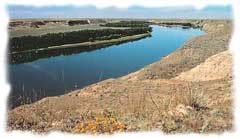- Reclamation
- Missouri Basin and Arkansas-Rio Grande-Texas Gulf
- Multimedia
- Lewis and Clark: Discovery of Missouri River by Early Americans, 1673
Lewis and Clark: Discovery of Missouri River by Early Americans, 1673

(Above) The Missouri River in Montana -
Photo courtesy of Travel Montana
The story of the Lewis and Clark expedition begins with the discovery of the Missouri River by early Americans.
The second longest river in the country has a list of names that rivals its length. In the Dakota Sioux language, the Missouri is Minni-Shu-Shu, Smoky-Water, or Minni-So-Say, Muddy-Water, or Wakpa-Sose-Tanka,Stirred-Up and Grandmother-River.
To the Hidatsas, it was Awati, Navigable-Stream-Full of Dirt. The Mandans called it Ma-Da-Hey, Boundary-Between-Two Pieces of Land. The Crows knew it as Big-River and the Omahas as Smoky-River. It was Steamboat-River to Cheyennes, while early white explorers named it Yellow-River.
The discovery of the Missouri River by white men is thought to have been in June 1673, when French explorers Louis Joliet and Father Jacques Marquette passed its violent mouth on their voyage of discovery down the Mississippi.
Other early white explorers on the Missouri included Sieur De la Verendrye and Gregoire Zerald Sharpy. The French had made progress along its course during the early 18th century.
In 1720, the Spaniards sent an expedition to destroy the Missouri Indians because they were allies of the French. The Missouris destroyed this expedition, but not until after the French had built a post 200 miles up the river on an island opposite the village of the Missouris.
This post was called Fort Orleans, and is considered the river's first structure built by white men. French-Canadian explorer and fur trader De la Verendrye searched throughout his life for the elusive Northwest Passage. Hearing stories from the Indians about a great river that flowed out of the west and using crude maps they had given him, De la Verendrye reached the Mandan Indian villages in present-day North Dakota in 1738. Whether he and his sons made it any farther west into Montana and to the Rocky Mountains is unknown.
De la Verendrye and his sons were interested in the business opportunities of finding new sources for the fur trade business. They were not alone. Before 1800, Spanish and French fur hunters were starting to invade its lengthy, serpentine course from the south. At the same time, other British and French fur traders from Canada discovered its rivers, and did business with the Mandan, Hidatsa, Arikara, Assiniboine, Cree and other nations living along the river on the Northern Plains.
The interest in this area was increasing, along with the dreams of the adventurers and explorers who traveled it.
This culminated at the dawn of the 19th century when an American President with a dream of westward expansion for his country made a land deal that doubled the size of his young country.
Thomas Jefferson prevailed upon Congress to make possible the assembly of a corps of intrepid explorers to discover this new country. In this Corps of Discovery were men of all circumstances of birth and life experiences, including a black slave, a teenage Indian woman with her baby, and a Newfoundland dog, who embarked on an expedition across the west that still reverberates today in the history of the United States.
The First Inhabitants
Yet, their river journey did not take them into uninhabited land. Of the 50 Indian nations they encountered, roughly one third of them were living along or near the Missouri River. They were nations this river had sustained for thousands of years. The Missouri River had been a means of transportation, a source of food and a hub for commerce.
Records of the first people to live in the Upper Missouri states go back as far as 1010 B.C. People in the Archaic Period lived along small tributary streams that flow into the Missouri River valleys. The people of the Woodland Period lived in the area more than 1,000 years ago.
Early fur traders found the Mandan and Hidatsa in their villages of earthlodges along the Missouri near present-day Garrison Dam in the 1700s. Their villages served as major trading centers with the more nomadic tribes of the plains as well as travelers up the Missouri River and from waterways to the north.
Some of these northern Indian nations had done business with French and British fur traders out of Canada for many years. The Corps of Discovery's winter camp near present-day Washburn, North Dakota, which they called Fort Mandan, was situated among five villages of dome-shaped earth lodges of some 5,000 Mandans and Hidatsas. This population far exceeded the 3,000 people then living in St. Louis and Washington, D.C.
These villages interacted with the region's people through the steady stream of people coming through their villages. An example of this is the relative speed at which word traveled among the Upper Missouri fur trade communication network. Only 10 days after the Corps of Discovery members stopped to establish their winter camp with the Mandan and Hidatsa, word of their arrival reached Fort Assiniboine at the mouth of the Souris River in present-day central Manitoba.

